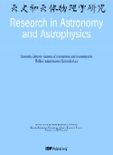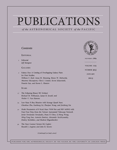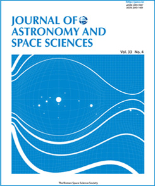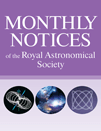
Kinematics and Physics of Celestial Bodies
Scope & Guideline
Transforming Understanding of the Universe's Mechanics
Introduction
Aims and Scopes
- Astrophysical Dynamics:
Research on the motion and interaction of celestial bodies, including studies of gravitational effects, orbital mechanics, and the behavior of various celestial phenomena. - Atmospheric and Ionospheric Physics:
Investigations into the physical processes occurring in planetary atmospheres and ionospheres, often involving the effects of solar activity and other cosmic events on atmospheric dynamics. - Seismology and Geomagnetic Studies:
Analysis of seismic activities and their impact on geomagnetic fields, including the study of ionospheric disturbances caused by terrestrial and extraterrestrial events. - Statistical and Computational Modeling:
Utilization of statistical methods and computational models to analyze celestial data, predict solar cycles, and understand the physical processes governing celestial bodies. - Wave Propagation Studies:
Research on various types of waves, such as acoustic-gravity waves and magnetohydrodynamic waves, in different media including the atmosphere and solar corona.
Trending and Emerging
- Impact of Solar Activity on Earth Systems:
An increased focus on how solar phenomena, such as solar flares and coronal mass ejections, affect terrestrial systems, particularly the atmosphere and ionosphere. - Multiscale Interactions in Geospace:
Emerging studies are exploring the interactions between different scales of geophysical phenomena, including the effects of seismic activities on the ionosphere and geomagnetic field. - Advanced GNSS Applications:
Growing interest in the application of Global Navigation Satellite Systems (GNSS) for precise measurements and monitoring of geophysical changes, particularly in relation to reference frames. - Statistical Analysis of Cosmic Events:
A trend towards applying statistical methods to analyze the likelihood and impact of cosmic events, such as interactions of globular clusters and solar cycle predictions. - Acoustic-Gravity Wave Research:
Emerging themes focusing on the properties and effects of acoustic-gravity waves in various atmospheric conditions and their implications for understanding atmospheric dynamics.
Declining or Waning
- Historical Studies of Astronomical Events:
There has been a noticeable decrease in papers focusing on historical analyses of astronomical events, suggesting a shift towards more contemporary and predictive studies. - Focus on Specific Celestial Phenomena:
Topics related to specific celestial events or isolated phenomena, such as singular solar flares or isolated meteoroid impacts, appear to be waning in favor of broader, integrative approaches. - Traditional Astrometry Techniques:
The decline in publications involving traditional astrometric methods suggests a shift towards more advanced techniques, such as GNSS technology and satellite observations.
Similar Journals

CONTEMPORARY PHYSICS
Fostering Interdisciplinary Collaboration for a Brighter FutureCONTEMPORARY PHYSICS, published by Taylor & Francis Ltd, stands as a notable journal in the field of physics and astronomy, offering a comprehensive platform for the dissemination of cutting-edge research and developments since its inception in 1959. With an Impact Factor that reflects its solid position within the academic community, as evidenced by its Q2 ranking in the 2023 category of Physics and Astronomy (miscellaneous) and a Scopus Rank of 111 out of 243, this journal plays an essential role in bridging theoretical advances and practical applications. Researchers and professionals are encouraged to explore its diverse scope, which aims to foster innovative ideas and foster interdisciplinary collaboration. Although not currently an open access journal, CONTEMPORARY PHYSICS is committed to maintaining the highest standards of editorial excellence and provides valuable insights across converged eras of research from 1959 to 2024, making it indispensable for those dedicated to advancing their knowledge and contributions in the realm of physics.

Research in Astronomy and Astrophysics
Connecting Minds Across the Celestial Realm.Research in Astronomy and Astrophysics, published by the National Astronomical Observatories under the Chinese Academy of Sciences, stands out as a pivotal platform for disseminating cutting-edge research in the fields of astronomy and astrophysics. With an ISSN of 1674-4527 and an E-ISSN of 2397-6209, this esteemed journal operates as an open access publication, ensuring that high-quality research is available to a broad audience without any financial barriers. As of 2023, it holds a commendable Q2 quartile ranking in both Astronomy and Astrophysics, as well as Space and Planetary Science, reflecting its importance and revered position among leading journals. Spanning from 2009 to 2024, it is geographically rooted in the United Kingdom but engages a global readership and author base, making significant contributions to the rapidly evolving discourse in astrophysical studies. Moreover, its rankings in Scopus underscore its relevance, ranking 43rd out of 90 in Astronomy and Astrophysics and 61st out of 104 in Space and Planetary Science, placing it firmly within the competitive landscape of scientific research. Research in Astronomy and Astrophysics is dedicated to fostering innovation and communication within the scientific community, offering researchers, professionals, and students alike a valuable resource for collaboration and knowledge advancement.

Bulgarian Astronomical Journal
Advancing Knowledge in Astronomy and AstrophysicsThe Bulgarian Astronomical Journal, published by the BULGARIAN ACADEMY OF SCIENCES, INSTITUTE OF ASTRONOMY, serves as a vital platform for the dissemination of research in the field of Astronomy and Astrophysics. With the ISSN 1313-2709 and E-ISSN 1314-5592, this journal has been pivotal in showcasing original studies and advancements in astronomical sciences from 2014 and will continue to do so through 2025. Although categorized in Q4 within the ambit of Astronomy and Astrophysics, it provides essential insights and innovative findings, making significant contributions to the global academic community. Positioned in the lower quartile of Scopus rankings, recognized as #87 out of 90, it offers an opportunity for burgeoning researchers and seasoned professionals alike to engage with emerging ideas and trends in the discipline. While it currently does not feature an open access model, readers and contributors can anticipate a rich exchange of scientific knowledge that fosters collaboration within the astronomy community.

REVISTA MEXICANA DE ASTRONOMIA Y ASTROFISICA
Unraveling the Mysteries of the Universe TogetherRevista Mexicana de Astronomía y Astrofísica, published by the Universidad Nacional Autónoma de México (INSTITUTO DE ASTRONOMÍA), is a prominent academic journal dedicated to advancing the knowledge and understanding of astronomy and astrophysics. As a Q3-ranked journal in both Astronomy and Astrophysics, and Space and Planetary Science in 2023, it serves as an invaluable platform for researchers and professionals within these fields. With an ISSN of 0185-1101, this journal seeks to foster innovative research and dialogue among scholars, presenting groundbreaking studies spanning from theoretical astrophysics to observational astronomy. Although it does not operate under an open-access model, the journal remains vital for its contributions to scientific literature from Mexico, with articles converging over several decades from 1996 to 2024. By offering insights into the latest findings and methodologies, Revista Mexicana de Astronomía y Astrofísica not only enhances the academic landscape but also inspires future generations of scientists and students passionate about unraveling the mysteries of the universe.

PHYSICS-USPEKHI
Fostering Collaboration in the Heart of PhysicsPHYSICS-USPEKHI, published by Uspekhi Fizicheskikh Nauk, is a prominent peer-reviewed journal in the field of physics and astronomy, reaching researchers and professionals since its inception in 1993. With an ISSN of 1063-7869 and an E-ISSN of 1468-4780, this esteemed journal has been classified as Q2 in the Physics and Astronomy category based on the 2023 quartiles, ranking 74 out of 243 journals in its Scopus classification, placing it in the 69th percentile. Although currently not an open access journal, it provides invaluable insights and advancements in the field, fostering an environment for scholarly exchange and collaborative research. Based in Moscow, Russia, PHYSICS-USPEKHI continues to shape the landscape of theoretical and experimental physics, inviting submissions that contribute to its rich legacy of high-impact scientific discourse.

PUBLICATIONS OF THE ASTRONOMICAL SOCIETY OF THE PACIFIC
Advancing the Frontiers of Astronomy and AstrophysicsPublications of the Astronomical Society of the Pacific is a prestigious journal dedicated to advancing the fields of Astronomy and Astrophysics, as well as Space and Planetary Science. Published by IOP Publishing Ltd, this influential journal plays a critical role in disseminating groundbreaking research and innovative findings. With an impressive Q1 ranking in both related categories according to the 2023 metrics, it is recognized among the top journals in its field. As a vital resource for researchers, professionals, and students alike, the journal covers a range of topics relevant to current astronomical research from 1996 to 2024. Although it does not offer open access options, the journal is highly regarded in academic circles, evidenced by its competitive ranking in Scopus—20th in Astronomy and Astrophysics and 26th in Space and Planetary Science. This commitment to excellence ensures that it remains an essential platform for sharing the latest insights in the ever-evolving universe.

PUBLICATIONS OF THE ASTRONOMICAL SOCIETY OF JAPAN
Empowering researchers to reach for the stars.Publications of the Astronomical Society of Japan is a prestigious, peer-reviewed journal dedicated to advancing the field of astronomy and astrophysics. Published by Oxford University Press, this journal provides a platform for high-quality research, fostering scientific communication among both established researchers and emerging scholars. With an ISSN of 0004-6264 and E-ISSN 2053-051X, it is recognized for its significant impact in its field, boasting a Q2 ranking in both Astronomy and Astrophysics and Space and Planetary Science as of 2023. The journal seeks to bridge traditional and innovative approaches to expand understanding of celestial phenomena, making it an essential resource for professionals, students, and researchers alike. Researchers can access a wealth of cutting-edge studies spanning theoretical and observational aspects of astronomy from its inception in 1996 to the present day. Although the journal operates under a traditional access model, it remains a respected forum for pivotal discoveries and discussions within the global astronomical community.

Journal of Astronomy and Space Sciences
Illuminating the Universe Through Rigorous Research.The Journal of Astronomy and Space Sciences, published by the Korean Space Science Society, is a premier open-access platform dedicated to advancing the fields of astronomy, astrophysics, and space sciences. Established in 1984, the journal has been instrumental in disseminating high-quality research findings, fostering collaboration among scientists globally, and providing insights into the dynamics of our universe. With an ISSN of 2093-5587 and an E-ISSN of 2093-1409, the journal has gained notable recognition, currently ranking in the Q3 quartile in Earth and Planetary Sciences and Physics and Astronomy as of 2023. Although the journal's H-Index is currently unspecified, its commitment to rigorous peer-review processes and open-access availability ensures that groundbreaking research is accessible to a wide audience. Based in Seoul, South Korea, the journal is poised to continue supporting innovative research through 2024 and beyond. Researchers, professionals, and students alike will find valuable resources and opportunities within its pages, further establishing this journal as a crucial resource in the exploration of the cosmos.

SOLAR PHYSICS
Pioneering Solar Research: Bridging Theory and ObservationSOLAR PHYSICS, published by SPRINGER, serves as a pivotal platform for the dissemination of groundbreaking research in the fields of Astronomy and Astrophysics, as well as Space and Planetary Science. With an impressive impact factor and ranked Q2 in both categories as of 2023, this esteemed journal has become integral for scholars seeking to advance their knowledge in solar phenomena and related disciplines. Originating from the Netherlands and converging from 1967 to 2024, SOLAR PHYSICS features a diverse array of articles, from observational studies to theoretical analyses, contributing significantly to our understanding of solar activity and its influence on the heliosphere and beyond. Researchers, professionals, and students alike will find this journal an indispensable resource for current trends and comprehensive insights in solar research.

MONTHLY NOTICES OF THE ROYAL ASTRONOMICAL SOCIETY
Elevating Astronomy Research to New Heights.The MONTHLY NOTICES OF THE ROYAL ASTRONOMICAL SOCIETY (MNRAS), published by Oxford University Press, serves as a premier platform for the dissemination of significant research in the fields of Astronomy, Astrophysics, and Space and Planetary Science. Established in 1913 and with an impressive impact factor reflected in its 2023 Q1 rankings—13th in Earth and Planetary Sciences and 14th in Physics and Astronomy—this journal is renowned for its rigorous peer-reviewed articles, fostering advancements in our understanding of the universe. Researchers, professionals, and students alike benefit from its rich content, which spans a vast array of topics within its scope, from stellar dynamics to planetary formation. While the journal does not currently offer Open Access options, the scholarly contributions published herein are invaluable for pushing the boundaries of contemporary scientific inquiry and ensuring that the latest findings reach an engaged audience globally.